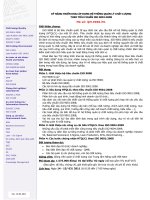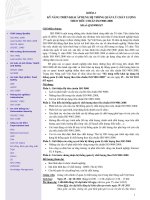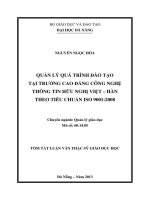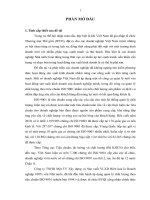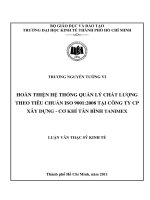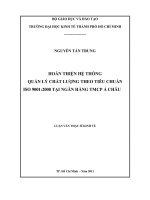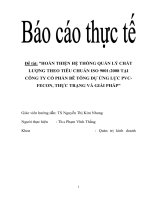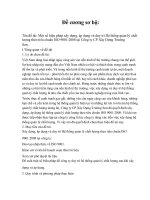Tiêu chuẩn iso 01496 2 2008
Bạn đang xem bản rút gọn của tài liệu. Xem và tải ngay bản đầy đủ của tài liệu tại đây (763.09 KB, 72 trang )
ISO
1496-2
INTERNATIONAL
STANDARD
Fifth edition
2008-07-15
Series 1 freight containers —
Specification and testing —
Part 2:
Thermal containers
Conteneurs de la série 1 — Spécifications et essais —
Partie 2: Conteneurs à caractéristiques thermiques
Reference number
ISO 1496-2:2008(E)
© ISO 2008
ISO 1496-2:2008(E)
PDF disclaimer
This PDF file may contain embedded typefaces. In accordance with Adobe's licensing policy, this file may be printed or viewed but
shall not be edited unless the typefaces which are embedded are licensed to and installed on the computer performing the editing. In
downloading this file, parties accept therein the responsibility of not infringing Adobe's licensing policy. The ISO Central Secretariat
accepts no liability in this area.
Adobe is a trademark of Adobe Systems Incorporated.
Details of the software products used to create this PDF file can be found in the General Info relative to the file; the PDF-creation
parameters were optimized for printing. Every care has been taken to ensure that the file is suitable for use by ISO member bodies. In
the unlikely event that a problem relating to it is found, please inform the Central Secretariat at the address given below.
COPYRIGHT PROTECTED DOCUMENT
© ISO 2008
All rights reserved. Unless otherwise specified, no part of this publication may be reproduced or utilized in any form or by any means,
electronic or mechanical, including photocopying and microfilm, without permission in writing from either ISO at the address below or
ISO's member body in the country of the requester.
ISO copyright office
Case postale 56 • CH-1211 Geneva 20
Tel. + 41 22 749 01 11
Fax + 41 22 749 09 47
Web www.iso.org
Published in Switzerland
ii
© ISO 2008 – All rights reserved
ISO 1496-2:2008(E)
Contents
Page
Foreword............................................................................................................................................................ iv
Introduction ........................................................................................................................................................ v
1
Scope ..................................................................................................................................................... 1
2
Normative references ........................................................................................................................... 1
3
Terms and definitions........................................................................................................................... 1
4
Classification......................................................................................................................................... 3
5
Marking .................................................................................................................................................. 3
6
Dimensions and ratings ....................................................................................................................... 3
7
Design requirements ............................................................................................................................ 5
8
Testing ................................................................................................................................................... 9
9
Electrical aspects of thermal containers.......................................................................................... 24
Annex A (normative) Diagrammatic representation of capabilities appropriate to all types and
sizes of thermal containers, except where otherwise stated ......................................................... 27
Annex B (normative) Details of requirements for load-transfer areas in base structures of
containers ............................................................................................................................................ 33
Annex C (normative) Dimensions of fork-lift pockets (where provided).................................................... 40
Annex D (normative) Dimensions of gooseneck tunnels (where provided) .............................................. 42
Annex E (normative) Cooling water connections ......................................................................................... 43
Annex F (normative) Air inlets and outlets.................................................................................................... 46
Annex G (normative) Mounting of clip-on units............................................................................................ 51
Annex H (normative) Air temperature measurement points........................................................................ 54
Annex I (normative) Steady-state conditions for heat leakage test (Test No. 14) ..................................... 56
Annex J (normative) Phase connections to container plugs and sockets ................................................ 57
Annex K (normative) Electric plug and socket, four-pin, 380/440 V, 50/60 Hz, 32 A ................................. 58
Annex L (normative) Electrical power supplies for thermal containers (9.2) ............................................ 62
Annex M (normative) General requirements for 220 volt and dual voltage equipment ............................ 63
Annex N (informative) Conversion of SI units to non-SI units..................................................................... 64
Bibliography ..................................................................................................................................................... 65
© ISO 2008 – All rights reserved
iii
ISO 1496-2:2008(E)
Foreword
ISO (the International Organization for Standardization) is a worldwide federation of national standards bodies
(ISO member bodies). The work of preparing International Standards is normally carried out through ISO
technical committees. Each member body interested in a subject for which a technical committee has been
established has the right to be represented on that committee. International organizations, governmental and
non-governmental, in liaison with ISO, also take part in the work. ISO collaborates closely with the
International Electrotechnical Commission (IEC) on all matters of electrotechnical standardization.
International Standards are drafted in accordance with the rules given in the ISO/IEC Directives, Part 2.
The main task of technical committees is to prepare International Standards. Draft International Standards
adopted by the technical committees are circulated to the member bodies for voting. Publication as an
International Standard requires approval by at least 75 % of the member bodies casting a vote.
Attention is drawn to the possibility that some of the elements of this document may be the subject of patent
rights. ISO shall not be held responsible for identifying any or all such patent rights.
ISO 1496-2 was prepared by Technical Committee ISO/TC 104, Freight containers, Subcommittee SC 2,
Specific purpose containers.
This fifth edition cancels and replaces the fourth edition (1996) which has been technically revised. It also
incorporates the Amendment ISO 1496-2:1996/Amd. 1:2006 and the Technical Corrigendum
ISO 1496-2:1996/Cor. 1:1997. The main changes are:
⎯
ISO 1496-2:1996/Amd. 1:2006 has been incorporated;
⎯
1EE and 1EEE containers have been added to Table 1;
⎯
ventilation control and humidity control have been added as 7.9.9 and 7.9.10;
⎯
a new test, 8.17 Test No. 15 b) Functional test of a thermal container at high ambient temperatures while
being cooled by a mechanical refrigeration unit (MRU), has been added and the following tests have been
renumbered;
⎯
in 8.14.3, the air leakage rate requirement has been revised to not exceed 5 m3/h;
⎯
clarification has been given in 8.16.1.1, 8.16.2.1, 8.12.1 and in a note to 9.4;
⎯
the requirements given in Table 4 have been corrected.
The opportunity was also taken for an editorial revision to update the style.
ISO 1496 consists of the following parts, under the general title Series 1 freight containers — Specification
and testing:
⎯
Part 1: General cargo containers for general purposes
⎯
Part 2: Thermal containers
⎯
Part 3: Tank containers for liquids, gases and pressurized dry bulk
⎯
Part 4: Non-pressurized containers for dry bulk
⎯
Part 5: Platform and platform-based containers
iv
© ISO 2008 – All rights reserved
ISO 1496-2:2008(E)
Introduction
The following grouping of container types is used for specification purposes in ISO 1496:
Part 1
General purpose
Specific purpose
closed, vented/ventilated
open top
10 to 19
50 to 59
Part 2
Thermal
30 to 49
Part 3
Tank
Bulk, pressurized
70 to 79
85 to 89
Part 4
Bulk, non-pressurized (box type)
Bulk, non-pressurized (hopper type)
20 to 24
80 to 84
Part 5
Platform (container)
Platform-based, with incomplete superstructure
and fixed ends
Platform-based, with incomplete superstructure
and folding ends
Platform-based, with complete superstructure
NOTE
00 to 09
60
61 and 62
63 and 64
65 to 69
Container groupings for parts 1 and 3 to 5 inclusive are described in detail in the relevant parts of ISO 1496.
© ISO 2008 – All rights reserved
v
INTERNATIONAL STANDARD
ISO 1496-2:2008(E)
Series 1 freight containers — Specification and testing —
Part 2:
Thermal containers
1
Scope
This part of ISO 1496 gives the basic specifications and testing requirements for ISO series 1 thermal
containers for international exchange and for conveyance of goods by road, rail and sea, including
interchange between these forms of transport.
NOTE
For the convenience of users of this part of ISO 1496, the conversion of values expressed in SI units to values
expressed in non-SI units is given in Annex N.
--`,``,`,,,```,,,,,`,,`,`,`,`,,`-`-`,,`,,`,`,,`---
2
Normative references
The following referenced documents are indispensable for the application of this document. For dated
references, only the edition cited applies. For undated references, the latest edition of the referenced
document (including any amendments) applies.
ISO 668:1995, Series 1 freight containers — Classification, dimensions and ratings
ISO 830:1981, Freight containers — Vocabulary
ISO 1161:1984, Series 1 freight containers — Corner fittings — Specification
ISO 6346:1995, Freight containers — Coding, identification and marking
ISO 10368:2006, Freight thermal containers — Remote condition monitoring
IEC 60947-1, Low-voltage switchgear and controlgear — Part 1: General rules
3
Terms and definitions
For the purposes of this document, the general terms and definitions given in ISO 830 and the following apply.
3.1
thermal container
freight container having insulating walls, doors, floor and roof designed to retard the rate of heat transmission
between the inside and the outside of the container
3.2
insulated container
thermal container having no devices for cooling and/or heating, either permanently installed or attached
© ISO 2008 – All rights reserved
1
ISO 1496-2:2008(E)
3.3
refrigerated container (expendable refrigerant)
thermal container using a means of cooling such as liquefied gases, with or without evaporation control
NOTE
It is implicit in this definition that such a container requires no external power or fuel supply.
3.4
mechanically refrigerated container
thermal container served by a refrigerating appliance (mechanical compressor unit, absorption unit, etc.)
3.5
heated container
thermal container served by a heat-producing appliance
3.6
refrigerated and heated container
thermal container served by a refrigerating appliance (mechanical or using expendable refrigerant) and a
heat-producing appliance
3.7
refrigerated and heated container with controlled or modified atmosphere
thermal container served by a refrigerating and heat-producing appliance, initially loaded with a modified
atmosphere and/or capable of generating and/or maintaining a modified atmosphere
3.8
removable equipment
refrigerating and/or heating appliance, power-generating unit or other equipment designed to be attached or
detached from a freight container
3.9
located internally
totally within the external dimensional envelope of the freight container as defined in ISO 668
3.10
located externally
partially or totally outside the external dimensional envelope of the container as defined in ISO 668
NOTE
It is implicit in this definition that an appliance located externally has to be removable or retractable to facilitate
transport in certain modes.
3.11
batten
member protruding from the inside walls of the container to hold the cargo away from the wall to provide an air
passage
NOTE
The member may be integral with the wall, fastened to the wall or added during cargo loading.
3.12
bulkhead
partition providing a plenum chamber and/or air passage for either return or supply air
NOTE
The partition may be an integral part of the appliance or a separate member.
3.13
ceiling air duct
passage or passages located in proximity to the ceiling to direct air flow
3.14
floor air duct
passage or passages located beneath the cargo support surface to direct air flow
--`,``,`,,,```,,,,,`,,`,`,`,`,,`
2
© ISO 2008 – All rights reserved
ISO 1496-2:2008(E)
3.15
pin mounting
mounting system using two vertical pins engaging mating sockets built into the top end transverse member
such that the entire mass of the removable equipment is supported by the top end transverse member
3.16
lower mounting points
threaded receptacles to which the lower two corners of the removable equipment are fastened
4
Classification
The container types covered by this part of ISO 1496 are classified as shown in Table 1, in which the
maximum allowable heat-leakage rates are specified.
A conversion table for kelvins to degrees Celsius is given for convenience in Table 2.
--`,``,`,,,```,,,,,`,,`,`,`,`,,`-`-`,,`,,`,`,,`---
5
Marking
The marking of thermal containers shall be in accordance with ISO 6346.
In addition, thermal containers intended to carry hanging cargo and thermal containers given a modified
atmosphere shall be marked in accordance with 7.9.7 and 7.9.8.
6
6.1
Dimensions and ratings
External dimensions
The overall external dimensions and tolerances of the freight containers covered by this part of ISO 1496 shall
be in accordance with ISO 668. No part of the container shall project beyond these specified overall external
dimensions.
6.2
Internal dimensions
Internal dimensions of thermal containers shall be measured from inner faces of battens, bulkheads, ceiling air
ducts, floor air ducts, etc., where fitted.
The minimum internal dimensions for ISO series 1 thermal freight containers are specified in Table 3.
Internal dimensions of thermal containers should be as large as possible.
6.3
Ratings
The values of the rating R, where R is the maximum gross mass of the container, are those given in ISO 668.
© ISO 2008 – All rights reserved
3
ISO 1496-2:2008(E)
Table 1 — Classification of thermal containers
Type, code
designation
Description
Maximum heat-leakage rate 1), Umax, for freight
containers
Design
temperatures 2)
Inside
W/K
1D
1C,
1CC
1B,
1BB
1BBB
1A,
1AAA
1AA
Outside
1EE
1EEE
K
∞C
K
∞C
30
Refrigerated
(expendable refrigerant)
13
22
31
33
40
42
44
46
255
−18
318
+45
31
Mechanically
refrigerated
13
22
31
33
40
42
44
46
255
−18
318
+45
Refrigerated and
heated
13
22
31
33
40
42
44
46
289
+16
32
253
−20
255
−18
318
+45
Heated
13
22
31
33
40
42
44
46
289
+16
253
−20
255
−18
318
+45
289
+16
253
−20
255
−18
318
+45
289
+16
253
−20
33
34, 35
Unassigned
36
Mechanically
refrigerated, selfpowered
13
22
31
33
40
42
44
46
37
Refrigerated and
heated, self-powered
13
22
31
33
40
42
44
46
38
Heated, self-powered
13
22
31
33
40
42
44
46
39
Unassigned
40
Refrigerated and/or
heated, with removable
equipment, appliance
located externally
13
22
31
33
40
42
44
46
41
Refrigerated and/or
heated, with removable
equipment, appliance
located internally
13
22
31
33
40
42
44
46
42
Refrigerated and/or
heated, with removable
equipment, appliance
located externally
26
46
66
71
86
92
44
46
43, 44
Unassigned
45
Insulated 3) 4)
13
22
31
33
40
42
46
Insulated 3) 4)
26
46
66
71
86
92
47, 48, 49
Unassigned
1)
The values of Umax for heavily insulated containers (types 30, 31, 32, 33, 36, 37, 40, 41 and 45) are better than a
coefficient of heat transfer, K, of 0,4 W/(m2⋅K). The values of Umax for lightly insulated containers (types 42 and 46) are related
to an approximate coefficient of heat transfer, K, of 0,7 W/(m2⋅K).
2)
See Table 2.
3)
This category does not have design temperatures; the actual performance is dependent on the capability of the equipment
attached in any transport mode.
4)
Types 42, 45 and 46 are included for information but are no longer produced.
4
© ISO 2008 – All rights reserved
ISO 1496-2:2008(E)
Table 2 — Kelvins to degrees Celsius conversion table
--`,``,`,,,```,,,,,`,,`,`,`,`,,`-`-`,,`,,`,`,,`---
NOTE
Kelvin
K
Degree Celsius
∞C
0
273,15
−273,15
0
253
−20
255
−18
285
+12
288
+15
289
+16
293
+20
298
+25
305
+32
311
+38
318
+45
323
+50
For the purposes of temperature differences, 1 K = 1 ∞C.
Table 3 — Minimum internal dimensions
Dimensions in millimetres
Type code
designation
Minimum length a
Minimum width
= Nominal container
external width minus
Minimum height a
(no gooseneck tunnel)
= Nominal container
external height minus
Minimum height a
(with gooseneck tunnel)
= Nominal container
external height minus
= Nominal container
external length minus
220
345
385
30, 31, 32, 33
690
36, 37, 38, 41
990
40
440
42
390
180
310
350
45
340
220
285
340
46
290
180
250
290
NOTE
Some thermal containers built to conform with earlier editions of this part of ISO 1496 are significantly smaller, particularly
if a diesel generator is fitted.
a
7
7.1
Some of the length and height dimensions specified will necessarily be used for air circulation.
Design requirements
General
All thermal containers shall comply with the following requirements.
The strength requirements for containers are given in diagrammatic form in Annex A (these requirements are
applicable to all thermal containers except where otherwise stated). They apply to containers as complete
units, except as envisaged in 8.1.
© ISO 2008 – All rights reserved
5
ISO 1496-2:2008(E)
The strength requirements for corner fittings (see also 7.2) are specified in ISO 1161.
The thermal container shall be capable of withstanding the loads and loadings specified in Clause 8.
As the effects of loads encountered under any dynamic operating condition should only approach, but not
exceed, the effects of the corresponding test loads, it is implicit that the capabilities of thermal containers as
indicated in Annex A and demonstrated by the tests described in Clause 8 shall not be exceeded in any mode
of operation.
Any closure in a container, which if unsecured could lead to a hazardous situation, shall be provided with an
adequate securing system having external indication of the positive securement of that closure in the
appropriate operation position. In particular, doors should be capable of being securely fastened in the open
or closed position.
The walls, doors, floors and roof of the thermal container shall be insulated in such a manner as to balance,
as far as is practicable, the heat transfer through each of them, although the roof insulation may be increased
to compensate for solar radiation.
7.2
Corner fittings
All containers shall be equipped with top and bottom corner fittings. The requirements and positioning of the
corner fittings shall be in accordance with ISO 1161. The upper faces of the top corner fittings shall protrude
above the top of the container by a minimum of 6 mm (see 7.3.4). The “top of the container” means the
highest level of the cover of the container.
However, if reinforced zones or doubler plates are provided to afford protection to the roof in the vicinity of the
top corner fittings, such plates and their securements shall not protrude above the upper faces of the top
corner fittings. These plates shall not extend more than 750 mm from either end of the container but may
extend the full width.
7.3
7.3.1
Base structure
All containers shall be capable of being supported by their bottom corner fittings only.
7.3.2 All containers, other than 1D, shall also be capable of being supported only by load-transfer areas in
their base structure.
Consequently, these containers shall have end transverse members and sufficient intermediate load-transfer
areas (or a flat underside) of sufficient strength to enable vertical load transfer to or from the longitudinal
members of a carrying vehicle. Such longitudinal members are assumed to lie within the two 250 mm wide
zones defined by the dashed lines in Figure B.1.
The lower faces of the load-transfer areas, including those of the end transverse members, shall be in one
plane located 12,5 mm +−5,0
1,5 mm above the plane of the lower faces of the bottom corner fittings and bottom
side rail. Apart from the bottom corner fittings and bottom side rails, no part of the container shall project
below this plane. However, doubler plates may be provided in the vicinity of the bottom corner fittings to afford
protection to the understructure.
Such plates shall not extend more than 550 mm from the outer end and not more than 470 mm from the side
faces of the bottom corner fittings, and their lower faces shall be at least 5 mm above the lower faces of the
bottom corner fittings of the container.
Containers having all their intermediate transverse members spaced 1 000 mm apart or less (or having a flat
underside) shall be deemed to comply with the requirements given in the second paragraph of this sub-clause.
Requirements for containers not having transverse members spaced 1 000 mm apart or less (and not having
a flat underside) are given in Annex B.
6
© ISO 2008 – All rights reserved
ISO 1496-2:2008(E)
7.3.3 For 1D containers, the level of the underside of the base structure is not specified, except as implied
in 7.3.4.
7.3.4 For all containers under dynamic conditions, or the static equivalent thereof, with the container having
a load uniformly distributed over the floor in such a way that the combined mass of the container and test load
is equal to 1,8R, no part of the base of the container shall deflect more than 6 mm below the base plane (lower
faces of the bottom corner fittings).
7.3.5 The base structure shall be designed to withstand all forces, particularly lateral forces, induced by the
cargo in service. This is particularly important where provisions are made for securing the cargo to the base
structure of the container.
7.4
End structure
For all thermal containers other than 1D, the sideways deflection of the top of the container with respect to the
bottom of the container, at the time it is under full transverse rigidity test conditions, shall not cause the sum of
the changes in length of the two diagonals to exceed 60 mm.
NOTE
It should be noted that the rigidity of the end structure of a container fitted with an internally located
refrigeration unit is not necessarily equal to the sum of rigidities of container and unit, but is also dependent on the way in
which the unit is fitted.
7.5
Side wall structure
For all thermal containers other than 1D, the longitudinal deflection of the top of the container with respect to
the bottom of the container when under full longitudinal-rigidity test conditions shall not exceed 25 mm.
7.6
Walls
Where openings are provided in end or side walls, the ability of these walls to withstand tests Nos. 5 and 6
shall not be impaired.
7.7
Door opening
Each thermal container shall be provided with a door opening at least at one end.
All door openings and end openings shall be as large as possible.
The usable width shall correspond with the appropriate minimum internal dimension given in Table 3.
The usable height shall be as close as practicable to the appropriate minimum internal dimension given in
Table 3.
7.8
Sanitary and taint-free requirements
Attention is drawn to the need for the proper choice of materials for the thermal container and any
refrigerator/heating appliances to prevent adverse effects in cargo, especially foodstuffs. Any relevant national
or international requirements should also be considered.
The interior surface and container structure shall be so constructed as to facilitate cleaning, and the structure
and the insulation shall not be functionally affected by cleaning methods, for example steam cleaning and
detergents normally used.
No pockets shall exist inside the container that cannot be reached by conventional cleaning methods.
--`,``,`,,,```,,,,,`,,`,`,`,`,,`-`-`,,`,,`,`
If drains are fitted, provision shall be made to ensure that cleaning water can drain from the inside of the
container.
© ISO 2008 – All rights reserved
7
ISO 1496-2:2008(E)
7.9
Requirements for optional features
7.9.1
Fork-lift pockets
7.9.1.1
Fork-lift pockets used for handling 1CC, 1C and 1D thermal containers in the loaded or unloaded
condition may be provided as optional features.
Fork-lift pockets shall not be provided on 1AAA, 1AA, 1A, 1BBB, 1BB and 1B thermal containers.
7.9.1.2
Where a set of fork-lift pockets has been fitted as in 7.9.1.1, a second set of fork-lift pockets may,
in addition, be provided on 1CC and 1C containers for empty handling only.
The(se) additional pocket(s) which may in fact be one pocket paired with an existing pocket, provided in
accordance with 7.9.1.1, should be centred as closely as possible about the centre of gravity of the empty
container.
7.9.1.3
The fork-lift pockets, where provided, shall meet the dimensional requirements specified in
Annex C and shall pass completely through the base structure of the container so that lifting devices may be
inserted from either side. It is not necessary for the base of the fork-lift pockets to be the full width of the
container, but it shall be located in the vicinity of each end of the fork pockets.
--`,``,`,,,```,,,,,`,,`,`,`,`,,`-`-`,,`,,`,`,,`---
7.9.2
Gooseneck tunnels
Gooseneck tunnels shall be provided as mandatory features in 1AAA thermal containers and may be provided
as optional features in thermal containers 1AA, 1A, 1BB and 1B. The dimensional requirements are specified
in Annex D and, in addition, all other parts of the base structure shall be as specified in 7.3.
7.9.3
Drains
Cargo space drains which operate when carrying cargo, shall be protected by fittings which open
automatically above normal internal operating pressure. Drains required for cleaning of the interior of the
container shall be provided with manual closures.
Local customs and health requirements may place additional requirements on drains, which should be
adhered to.
7.9.4
Water connections
For appliances requiring water connections, the inlet and outlet interfaces shall be in accordance with Annex E.
Water-cooled appliances shall either be self-draining or incorporate the facility to drain the unit to prevent the
water from freezing.
The water inlet and outlet connections shall be so located at the machinery end of the container that, to an
observer facing that end, they appear in the lower right-hand quarter.
7.9.5
Air inlets and outlets
Where series 1AA, 1CC and 1C containers are designed for ducted air systems and for use with externally
located removable equipment, the air inlet and outlet openings shall conform to the requirements given in
Annex F.
7.9.6
Intermediate sockets for clip-on units
Where intermediate sockets are provided for use of clip-on units, they shall be located and designed in
accordance with Annex G.
8
© ISO 2008 – All rights reserved
ISO 1496-2:2008(E)
7.9.7
Hanging cargo facilities
The roof of containers may be designed to carry hanging cargo. Such containers shall meet the test
requirements specified in 8.8. Specific marking shall be placed on the inside of the container to indicate the
maximum hanging load.
7.9.8
Modified atmospheres
Thermal containers that are manufactured to operate with a modified atmosphere, which could be injurious to
health until appropriately vented, shall be so marked alongside each point of access.
7.9.9
Ventilation control
Where automated ventilation control is provided, this fact shall be clearly marked near the ventilation inlet(s).
7.9.10 Humidity control
Where humidity control to provide reduced humidity is provided by means of reheating only, there are no
additional requirements. Where humidity control incorporates addition of water as liquid or vapour, instructions
shall be provided for cleaning and disinfecting all water reservoirs.
8
Testing
8.1
General
8.1.1 Unless otherwise stated, thermal containers conforming to the design requirements specified in
Clause 7 shall, in addition, be capable of withstanding the tests specified in 8.2 to 8.19 inclusive, as applicable.
The refrigeration and/or heating equipment (for example components, framework, panelling, battens, ductwork,
bulkheads) need not necessarily be in place when the container is tested, except where so specified for a
particular test. But if any of the main parts or frameworks of the refrigeration and/or heating equipment is not
in position for any structural test, the ability of that part or framework to withstand the appropriate proportion of
any relevant cargo loading and/or the forces or accelerations to which the container and equipment may be
subjected in the service for which it was designed shall be established independently.
If parts of the refrigeration and/or heating equipment which contribute to the strength or integrity of the
container in service are not in position for structural testing, substitute framework and/or panelling may be
used, provided that it is secured in the same manner as the equipment and does not provide greater strength
than the original parts.
The test for heat leakage (Test No. 14) shall be used to measure the heat leakage rate from the container,
which determines its class. The tests described in 8.16. 8.17 and 8.18 [Tests Nos. 15 a), 15b) and 15 c)]
establish a standard method for testing the performance of mechanical and expendable liquid refrigeration
units respectively, when used in conjunction with a container of known class.
The tests for weatherproofness (Test No. 12), for airtightness (Test No. 13), for heat leakage (Test No. 14)
and for performance under refrigeration (Test No. 15) shall be carried out in sequence after completion of
Tests Nos. 1 to 11.
NOTE
Annex A gives examples of forces applied in the tests described in 8.2 to 8.12.
© ISO 2008 – All rights reserved
9
ISO 1496-2:2008(E)
8.1.2
The maximum payload, P, of the container to be tested is given by:
P = R −T
where
R
is the rating;
T
is the tare.
NOTE
R and T are expressed in units of mass. Where test requirements are based on the gravitational forces
derived from these values, those forces, which are inertial forces, are indicated thus:
Pg, Rg, Tg
the units of which are Newtons or multiples thereof.
The word “load”, when used to describe a physical quantity to which units may be ascribed, implies mass. The word
“loading”, for example as in “internal loading”, implies force.
8.1.3
The test loads or loadings within the thermal container shall be uniformly distributed.
8.1.4
The test loads or loadings specified in all of the following tests are minimum requirements.
8.1.5 The dimensional requirements to which reference is made in the requirements subclause after each
test are those specified in
a)
the dimensional and design requirement clauses of this part of ISO 1496,
b)
ISO 668,
c)
ISO 1161.
8.2
8.2.1
Test No. 1 — Stacking
General
This test shall be carried out to prove the ability of a fully loaded thermal container to support a superimposed
mass of containers, taking into account conditions aboard ships at sea and the relative eccentricities between
superimposed containers.
Table 4 specifies the test force to be applied to each pair of corner fittings and the superimposed mass that
the test force represents.
10
© ISO 2008 – All rights reserved
ISO 1496-2:2008(E)
Table 4 —Forces to be applied in the stacking test
Container
designation
Test force per container
(all four corners simultaneously)
Test force per pair of
end fittings
Superimposed mass
represented by test force
kN
lbf
kN
lbf
kg
lb
1A, 1AA and 1AAA
3 767
847 575
1 883
423 675
213 360
470 380
1B, 1BB and 1BBB
3 767
847 575
1 883
423 675
213 360
470 380
1C and 1CC
3 767
847 575
1 883
423 675
213 360
470 380
896
201 600
448
100 800
50 800
112 000
1D
8.2.2
Procedure
The thermal container shall be placed on four level pads, one under each bottom corner fitting. The pads shall
be centralized under the fittings and shall be essentially of the same plan dimensions as the fittings.
The container shall have a load uniformly distributed over the floor in such a way that the combined mass of
the container and the test load is equal to 1,8R.
The thermal container shall be subjected to vertical forces, applied either to all four corner fittings
simultaneously or to each pair of end fittings, at the appropriate level specified in Table 4. The forces shall be
applied through a test fixture equipped with corner fittings as specified in ISO 1161, or equivalent fittings which
have imprints of the same geometry (i.e. with the same external dimensions, chamfered aperture and rounded
edges) as the lower face of the bottom corner fittings specified in ISO 1161. If equivalent fittings are used,
they shall be designed to produce the same effect on the container under the test loads as when corner
fittings are used.
In all cases, the forces shall be applied in such a manner that rotation of the planes through which the forces
are applied and on which the container is supported is minimized.
Each corner fitting or equivalent test fitting shall be offset in the same direction by 25,4 mm laterally and
38 mm longitudinally.
8.2.3
Requirements
On completion of the test, the thermal container shall show neither permanent deformation which will render it
unsuitable for use nor abnormality which will render it unsuitable for use, and shall meet the dimensional
requirements (such as those given in ISO 1496-1) affecting handling, securing and interchange.
8.3
8.3.1
Test No. 2 — Lifting from the four top corner fittings
General
--`,``,`,,,```,,,,,`,,`,`,`,`,,`-`-`,,`,,`,`,,`---
This test shall be carried out to prove the ability of a thermal container, other than a 1D thermal container, to
withstand being lifted from the four top corner fittings with the lifting forces applied vertically, and the ability of
a 1D thermal container to withstand being lifted from the top corner fittings with the lifting forces applied at any
angle between the vertical and 60∞ to the horizontal. These are the only recognized methods of lifting these
containers by the four top corner fittings.
This test shall also be regarded as providing the ability of the floor and base structure to withstand the forces
arising from acceleration of the payload in lifting operations.
© ISO 2008 – All rights reserved
11
ISO 1496-2:2008(E)
8.3.2
Procedure
The thermal container shall have a load uniformly distributed over the floor in such a way that the combined
mass of the container and test load is equal to 2R, and it shall be carefully lifted from all four top corners in
such a way that no significant acceleration or deceleration forces are applied.
For a thermal container other than a 1D thermal container, the lifting forces shall be applied vertically.
For a 1D thermal container, lifting shall be carried out by means of slings, the angle of each leg being at 60∞
from the horizontal.
After lifting, the container shall be suspended for 5 min and then lowered to the ground.
8.3.3
Requirements
On completion of the test, the thermal container shall show neither permanent deformation which will render it
unsuitable for use nor abnormality which will render it unsuitable for use, and shall meet the dimensional
requirements affecting handling, securing and interchange.
8.4
Test No. 3 — Lifting from the four bottom corner fittings
8.4.1
General
This test shall be carried out to prove the ability of a thermal container to withstand being lifted from its four
bottom corner fittings by means of lifting devices bearing on the bottom corner fittings only and attached to a
single transverse central spreader beam above the container.
8.4.2
Procedure
The thermal container shall have a load uniformly distributed over the floor in such a way that the combined
mass of container and test load is equal to 2R, and it shall be carefully lifted from the side apertures of all four
bottom corner fittings in such a way that no significant acceleration or deceleration forces are applied.
Lifting forces shall be applied at:
⎯
30∞ to the horizontal for 1AAA, 1AA and 1A thermal containers;
⎯
37∞ to the horizontal for 1BBB, 1BB and 1B thermal containers;
⎯
45∞ to the horizontal for 1CC and 1C thermal containers;
⎯
60∞ to the horizontal for 1D thermal containers.
In each case, the line of action of the lifting force and the outer face of the corner fitting shall be no further
apart than 38 mm. The lifting shall be carried out in such a manner that the lifting devices bear on the four
bottom corner fittings only.
The container shall be suspended for 5 min and then lowered to the ground.
8.4.3
Requirements
On completion of the test, the thermal container shall show neither permanent deformation which will render it
unsuitable for use nor abnormality which will render it unsuitable for use, and shall meet the dimensional
requirements (such as those given in ISO 1496-1) affecting handling, securing and interchange.
12
© ISO 2008 – All rights reserved
ISO 1496-2:2008(E)
8.5
8.5.1
Test No. 4 — External restraint (longitudinal)
General
This test shall be carried out to prove the ability of a thermal container to withstand longitudinal external
restraint under dynamic conditions of railway operation, which implies accelerations of 2g.
8.5.2
Procedure
The thermal container shall have a load uniformly distributed over the floor in such a way that the combined
mass of the container and the uniformly distributed test load is equal to R, and it shall be secured
longitudinally to rigid anchor points through the bottom apertures of the bottom corner fittings at one end of the
thermal container.
A force of 2Rg shall be applied horizontally to the container through the bottom apertures of the other corner
fittings, first towards and then away from the anchor points.
8.5.3
Requirements
On completion of the test, the thermal container shall show neither permanent deformation which will render it
unsuitable for use nor abnormality which will render it unsuitable for use, and shall meet the dimensional
requirements affecting handling, securing and interchange.
8.6
8.6.1
Test No. 5 — Strength of end walls
General
This test shall be carried out to prove the ability of a thermal container to withstand forces under the dynamic
conditions referred to in 8.5.1.
8.6.2
Procedure
The thermal container shall have each end tested when one end is blind and the other equipped with doors. In
the case of symmetrical construction, one end only need be tested. The container shall be subjected to an
internal loading of 0,4Pg. The internal loading shall be uniformly distributed over the wall under test and
arranged to allow free deflection of the wall.
8.6.3
Requirements
On completion of the test, the thermal container shall show neither permanent deformation which will render it
unsuitable for use nor abnormality which will render it unsuitable for use, and shall meet the dimensional
requirements (such as those given in ISO 1496-1) affecting handling, securing and interchange.
8.7
8.7.1
Test No. 6 — Strength of side walls
General
--`,``,`,,,```,,,,,`,,`,`,`,`,,`-`-`,,`,,`,`,,`---
This test shall be carried out to prove the ability of a thermal container to withstand the forces resulting from
ship movement.
8.7.2
Procedure
The thermal container shall have each side wall tested. In the case of symmetrical construction, one side only
need be tested.
© ISO 2008 – All rights reserved
13
ISO 1496-2:2008(E)
Each side wall of the thermal container shall be subjected to an internal loading of 0,6Pg. The internal loading
shall be uniformly distributed, applied to each wall separately and arranged to allow free deflection of the side
wall and its longitudinal members.
8.7.3
Requirements
On completion of the test, the thermal container shall show neither permanent deformation which will render it
unsuitable for use, nor abnormality which will render it unsuitable for use, and shall meet the dimensional
requirements (such as those given in ISO 1496-1) affecting handling, securing and interchange.
8.8
8.8.1
Test No. 7 — Strength of the roof
General
This test shall be carried out to prove the ability of the roof of a thermal container to withstand the loads
imposed by persons working on it and, if the roof is intended to carry hanging cargo, the ability to carry a
maximum hanging load of 1 490 kg per metre of usable inside container length, taking into account a vertical
acceleration of 2g.
8.8.2
Procedure
A load of 300 kg shall be uniformly distributed over an area of 600 mm ¥ 300 mm located at the weakest area
of the roof of the thermal container.
If the roof is intended to carry hanging cargo, a load equal to twice the service load or twice 1 490 kg per
metre of usable container length, whichever is greater, shall be attached to the roof in a manner simulating
normal service loading, while the container is supported by its four bottom corner fittings only.
8.8.3
Requirements
On completion of the test, the thermal container shall show neither permanent deformation which will render it
unsuitable for use nor abnormality which will render it unsuitable for use, and shall meet the dimensional
requirements (such as those given in ISO 1496-1) affecting handling, securing and interchange.
8.9
8.9.1
Test No. 8 — Floor strength
General
This test shall be carried out to prove the ability of a container floor to withstand the concentrated dynamic
loading imposed during cargo operations involving powered industrial trucks or similar devices.
8.9.2
Procedure
The test shall be performed using a test vehicle equipped with tyres, with an axle load of 5 460 kg (i.e.
2 730 kg on each of two wheels). All points of contact between each wheel and a flat continuous surface shall
lie within a rectangular envelope measuring 185 mm (in a direction parallel to the axle of the wheel) by
100 mm and each wheel shall make physical contact over an area within this envelope of not more than
142 cm2. The wheel width shall be nominally 180 mm and the wheelbase shall be nominally 760 mm. The test
vehicle shall be manoeuvred over the entire floor area of the thermal container. The test shall be made with
the container resting on four level supports under its four bottom corner fittings, with its base structure free to
deflect.
8.9.3
Requirements
On completion of the test, the thermal container shall show neither permanent deformation which will render it
unsuitable for use nor abnormality which will render it unsuitable for use, and shall meet the dimensional
requirements (such as those given in ISO 1496-1) affecting handling, securing and interchange.
--`,``,`,,,```,,,,,`,,`,`,`,`,,`-`
14
© ISO 2008 – All rights reserved
